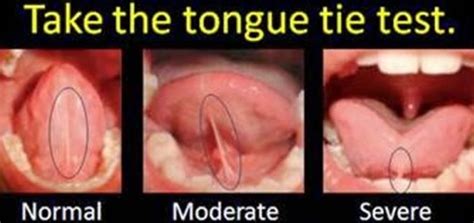What’s all this talk about tongue tie (ankyloglossia)?
By Chiropractor Dr. Graham Taylor
Did you know that the tongue position in the mouth is very important?
Why? The tongue is a very strong muscle and is viewed by orofacial experts as the “sculptor” of child facial development.
What does that mean? The tongue moves several thousands of times per day – during speech, eating, drinking, talking, swallowing and breathing. So proper tongue movement – coming from being positioned correctly with the tip resting just behind the two front teeth where they join the upper hard palate – helps mold the hard palate into a broader space (Roman arch), thus allowing proper dental development, a more open airway and preventing snoring. This means a lesser likelihood of upper respiratory infections and tonsillitis than with a higher, narrower (Gothic arch) shape which typically develops if the tongue is tied. This is often corrected with braces down the track (so get your youngsters checked to avoid orthodontic bills in the future!)
Even as a new baby, the tongue is an extremely important player. Proper movement of the tongue enables the baby to achieve an effective latch for milk extraction and proper swallowing. If a good seal is not achieved, difficulties creating a proper rhythmic flow will occur. This can lead to very sore nipples and mastitis and frustration for the mother as well as inability of the baby to ingest milk properly and keep it down. Common symptoms of tongue tie in a breastfeeding infant are: dribbling, vomiting, feeding taking a long time, falling asleep while feeding, colic (because they tend to swallow air while feeding) to name just a few. Often there is a switch to the bottle because “mum just doesn’t have enough milk” – but this is because after week 6 milk supply depends on the baby’s demand rather than on mum’s hormones. And just giving a bottle doesn’t necessarily help the problem (other than getting some food into the infant), who is still left with a hard time swallowing and inability to use the mouth properly, which will show up as other problems later in life.
Open airways are critical for a person to breathe through the nose. Why is that important? Because this avenue allows a more suitable ratio of CO2 : O2 in our body, thus maintaining blood pressure in a more normal range and keeping inflammation and stress levels under control. When there is a tongue tie, the airways are often narrower because the tongue hasn’t broadened the palate, and as a result, there is a tendency to breathe through the mouth. As a result, the breathing is too shallow, which leads to anxiety and often a diagnosis of ADHD. It also commonly leads to tonsillitis (tonsils weren’t meant to live exposed to the air all the time), which can narrow the airways even further, thus creating a vicious cycle.
As well as that, a lower tongue position tends to pull the head forward placing undue and pain inducing pressure on delicate spinal segments of the neck and upper shoulder region. Symptoms of this are forward head carriage, headaches and neck and shoulder tension. At first read of this it seems surprising that the humble tongue could cause such mischief!! But it is true, a higher positioned tongue allows the head to sit back more over the shoulders creating less drag on the spine.
How would I know if my child has (or I have) a tongue-tie?
There is evidence that tongue-tie affects behavior. Whilst “perfect behavior” is not the baseline referred to here – and depending on time of life – it may be that you have observed irritability, mood-swings, being easily distracted, inability to sit still, dribbling, unable to chew properly, fussy eater (regarding texture especially – things that require a lot of chewing, which needs the tongue to move around a lot) breathing with the mouth open, snoring, bedwetting unusually frequent for the age and dental cavities because the tongue cannot clean the teeth properly after eating.
And then there is the proverbial “tongue tied” child or adult – it can be very tricky to pronounce certain sounds, such as “s” or “sh” or “n” if your tongue can’t touch the palate properly.
Or as a baby – inability to get a good latch when feeding, colic type symptoms, not settling or sleeping well, persistent diarrhea, long periods of crying. If you are wondering about a baby you care about, have a look at where the tip of their tongue is when they cry: It should be near the top palate. If it is low in the mouth, it is probably tied.
Please note: it is normal to have a little “sail” between the tongue and the floor of the mouth. What makes a tongue tied is if there is not enough flexibility in the tissue to allow the tongue to move properly. Conversely, just being able to stick the tongue out of your mouth is also not a good enough indicator of how well the tongue functions, as the floor of the mouth will move to compensate.
What can be done?
There are various professionals who may offer an opinion as to, (a) whether there is a tongue-tie and (b) whether the tongue-tie is having unwanted effects.
In Australia is an organization called The Tongue Tie Institute who trains practitioners including Lactation Consultants, Midwives, Chiropractors, Osteopaths, Physiotherapists and Dentists about awareness and therapies. Having attended the training, we are encouraged to liaise with the other professionals because no one practitioner can do it all. For example, the Lactation Consultant may have identified the problem and recommended release of the tie. The release would be done by a Dentist trained in this area. The recommended bodywork (ie very gentle release tight muscles around the head and mouth) may be done by a Chiropractor trained in the Tongue Tie Institute approach. There is a fair amount of information to digest about this subject. Annika and Graham both have training with the Tongue Tie Institute as well as some post graduate pediatric training. Between them, there is around 40 years of experience in working with children and families. If you have any questions, please call our staff on 65501223 and we will do our best to provide any information you may seek.
Check out this case study

